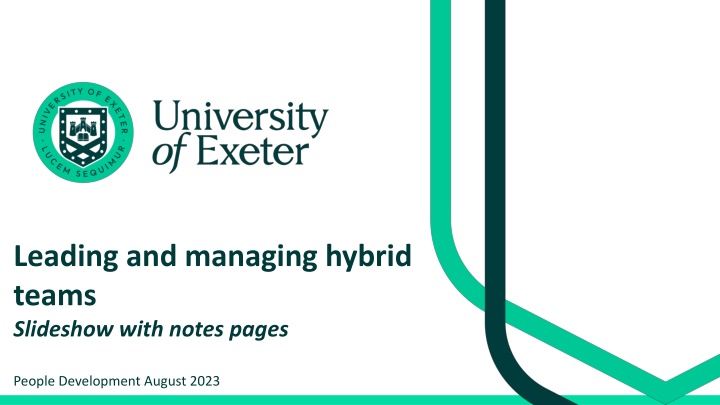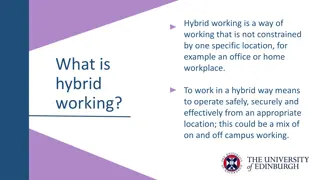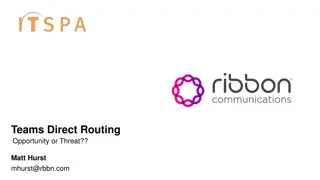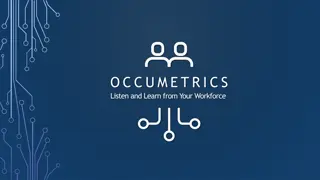Challenges and Strategies for Leading Hybrid Teams in the Workplace
Managing hybrid teams presents challenges related to changes in work culture, fear, crisis management, and more. Issues such as balance, loneliness, and disconnect can arise in hybrid working environments. Despite these challenges, effective communication, equity awareness, and strategic leadership can help overcome obstacles in leading hybrid teams successfully.
Download Presentation

Please find below an Image/Link to download the presentation.
The content on the website is provided AS IS for your information and personal use only. It may not be sold, licensed, or shared on other websites without obtaining consent from the author.If you encounter any issues during the download, it is possible that the publisher has removed the file from their server.
You are allowed to download the files provided on this website for personal or commercial use, subject to the condition that they are used lawfully. All files are the property of their respective owners.
The content on the website is provided AS IS for your information and personal use only. It may not be sold, licensed, or shared on other websites without obtaining consent from the author.
E N D
Presentation Transcript
Leading and managing hybrid teams Slideshow with notes pages People Development August 2023
Using this resource pack 1. The slides work best in slideshow mode as there are builds that present the information in a digestible format. 2. Most slides have further information, explanations and references to academic studies, discussion articles and thought pieces in the relevant notes page. Slides with such notes are marked with this symbol on the bottom right of the slide. N 3. At the end of the first section there are more slides and notes that explore some of the key topics in more detail. 4. This resource pack is updated on an annual basis so some items may be unavailable or out of date. University ofGalway.i e 5. We hope you find this pack useful.
What are the issues still? People continue to: 1. deal with multiple, significant changes 2. function from cultures, norms, relationships, and practices that were in place prior to the pandemicb be unfamiliar with working in a hybrid fashionc 3. experience coming and out of multiple crisesa,e 4. be fearfuld 5. University ofGalway.i e You may already be leading and managing your hybrid teams effectively: this resource pack, therefore, is a handy reminder! N
What does Hybrid mean.The Place-Time Axes Unconstrained The new Hybrid working The old Homeworking Anywhere, anytime Anywhere, 9-5 The old work PLACE The old Flexible working In the office, anytime In the office, 9-5 Constrained University ofGalway.i e TIME Constrained Unconstrained N Lynda Gratton (2021) In This hybrid future The Edge, Autumn 2021
Sowhat are the known challenges with Hybrid Working? Evidence suggests: Managers are less likely to engage in hybrid working, preferring more traditional office-attendance, than the people they manageh There can be problems with the balance of working from home*/working in an officea,b,f and also with logistics (who is working where and when)f We need to be aware of equity (facilities, career opportunitiesc, perks ): the second-class citizen trap d There may be problems with disconnect and lonelinesse Pets (and other interruptions) can be an issue A new phenomenon has emerged: Quiet quitting g University ofGalway.i e *this could of course also mean a caf or other location N
Concerns as managers and leaders* 1. Communication: people not staying in touch/not knowing what they are doing vs extreme email/message overload 2. Work/life balance, on and off campus and differences for individuals (eg carers, parents) 3.Boundariesaround new ways of working: what s acceptable and what isn t 4. Balancing different needs of individuals (working place/time/equipment/reasonable adjustments) 5. Finding time to switch off (you and your team) related to increased workload and back-to-back meetings 6. Back to the office finding and booking space and/or equipment, having meetings in shared spaces, challenges around hybrid meetings etc; making teams time on campus effective University ofGalway.i e *most recent feedback (2022) from University sources
What people* say are their top needs 1. Greater support with digital aspects of working 2. Greater support for staff with career development 3. Preventing isolation for remote and hybrid team members 4. More support needed for team cohesion, participating, collaborating, working with others and socialising with the team in a hybrid environment University ofGalway.i e * Findings of a New ways of working project conducted on campus in 2022
Four tips for effective hybrid leadership 1. Build team spirit 2. Foster (and model) a caring culture 3. Set clear expectations based on outcomes 4. Use technology effectively University ofGalway.i e
1. Build Team Spirit Foster the belief we are a team not a group of individuals Create Anchor days where you will all meet in person on a regular basis (monthly/Termly?) to encourage belonging Find opportunities for collaborative working This may include using appropriate technology to work across physical boundaries (SharePoint, One Drive, Yammer, Teams, Padlet, MURAL etc) Consider how you make meetings or workshops more inclusive and increase engagement and connection.a Use the 6 modes of working to structure working and collaboration time. b Work digitally first and asynchronously (where possible) b,c Ensure team feel represented, able to fully participate and highlight teams shared responsibility to each other.d Look after yourself and your team Keep considering your own wellbeing. Set realistic hours and prioritise tasks, so that your workload is sustainable. Stay in touch regularly. https://www.fearlessculture.design/blog-posts/how-to- collaborate-effectively-if-your-team-is-remote-or-hybrid N
2. Foster and model a caring culture Foster (and model) a caring culture Recognise the wellbeing and mental health challenge arising from the pandemic and other factors such as workloadf High Anxiety levelsa Mental healthb Depressionb Be open and honest about your own situation and vulnerabilityc Ask ourselves, as leaders, how can we foster and model a caring culture?d,e N
3. Set clear expectations focused on outcomes Clarity around place and time who is where, when Make sure you are available when you say you will be Be clear about your team members availability, who s working when and where It s much more important with hybrid teams that diaries and location messages are kept up to date Focus on outcomes and team deliverables a Need to set clear goals (SMART method) Have regular face to face check-ins, performance reviews and team meetings Work to prevent proximity bias Celebrate teams successes. Make it clear that colleagues can talk to you at any time with problems be approachable Things change rapidly at the moment so remain flexible with your plans N
4. Use technology effectively Collaboration & communication Sharing & storing files Major messaging Audit trails Replying in kind Meta-tagged files Replicated file structures Meeting files (Sits behind Teams ) Quick contact Bringing team in on topics Exchange of information Your own private space You can share You can synch with Teams/SharePoint Channelled information File sharing Channel threading Linking to other team work 1-1 records Quick notes OneNote N
In summary: to make hybrid working work for your team Positive and compassionate People focused Outcomes focused Develop effective behaviours Listen Give feedback Manage expectations Set clear goals Facilitate different opinionsb Share information equitablya Be comfortable with delegationb Use technology effectively Develop effective skills Create a team plan (together) Foster (and model) a caring culture Be visible, be present Make time for your team Make time for yourself Acknowledge and appreciate your team Deliver effective actions N
Further exploration of topics The following slides further explore a range of topics introduced in the previous slides.
Leading hybrid teams is differenta,b Performance management can no longer see productivity as hours spent at a computer but should be based on outcomes with clear goals. Also need to be conscious of proximity bias. g Have a range of styles in your leadership toolbox b Be fair, ensure staff who are working remotely are not excluded and have access to the same opportunities as those in the workplace (eg team-building activities and training)c Pilot new ways of working, check that it s working, offer alternatives where possiblec Be compassionate, cultivate a sense of togetherness d and a culture of belonging e, encourage collaborationf However, we seem to be skipping from one crisis to another so you will need to include direction and decision alongside coaching and democracy Normalise a culture where team can be their authentic selves and where it is fine to make mistakes supports development of a growth mindset. h Gain Use opportunity perspective Take control Leading in a crisis (from Noone & Forstner, 2020) N
CIPD (2021) tips1 1. Ensure your team are familiar with organisational policies and procedures 2. Think about the design of jobs and the structure of weekly or daily tasks. Reflect on what needs to change in terms of systems, processes or activities to support hybrid work. 3. Encourage team members to think about where and when they are most productive and tailor their working days and time accordingly. 4. Provide clarity to the team on their level of autonomy relating to hybrid working. For example, are individuals allowed to schedule their own hybrid days or are there reasons why they may be required to work a specific number/pattern of days? 5. Talk to individuals about their working styles and preferences relating to remote and hybrid work. Have ongoing dialogue and keep arrangements under review if circumstances change. 6. Encourage workers to disconnect meaningfully when working remotely, taking proper breaks and managing their digital wellbeing. 7. Manage individuals' workload effectively through agreeing realistic objectives, providing constructive feedback and joint problem solving to resolve issues which might cause people stress or to work excessive hours. 8. Be clear about their own availability and hybrid working schedule, including when and how to schedule time with them. 9. Schedule regular 121 time with every team member either virtually or face to face. Use this time for feedback, operational updates and checking in. 10. Encourage social connections between the team to support effective relationships. 11. Share team working patterns to provide clarity on who is working where and when. N
Challenges of hybrid working: evidence base and published discussions Team mutual knowledge may be lackinga Managers may be out of touch with individual needsb Family and home demands may impinge more directly on work at timesc Team members may lack a sense of belonging/engagementd Need technology to work more consistently to connect peoplee Individuals may suffer digital presenteeism ( compensatory )f and digital exhaustion Teams are more siloedg N
Thinking about being a positive and compassionate leader It s easier to connect more regularly Lots of new ways to bring other parts of life into conversations Meetings are more manageable Opportunity for me to pause and reflect Plenty of information available, regular updating Chance to work more to people s strengths
Compassionate and inclusive leadership Showing vulnerability is very powerful in the current context c Leaders also have to understand themselves c There are four key behavioursa Attending (the most important skill: listening with fascination b) Understanding Empathising Helping (the most important task: helping those we lead to do the job they do) Michael West who introduced the concept of compassionate leadership to the NHS. N
Are you positive and compassionate? Sometimes Empathy I sense others feelings and perspectives and take an active interest in their concerns. Always Never Kindness I am calm and I am generous with my attention and praise: I am mindful that people sometimes make mistakes and that this does not define them. Sometimes Always Never Sometimes Making time for others I make time in my busy life to be with the people I care about and I am honest and considerate of their needs. Always Never Sometimes Active listening I make an effort to listen attentively to other people with genuine interest, making sure I am not distracted by external or internal noise . Always Never Sometimes Being inclusive and equitable I am mindful that every individual is different and build my relationships accordingly, conscious that some people require more of me than others. Always Never Sometimes Appreciative I am thankful for what I have and I remind others that I am grateful to have them in my life. Always Never Sometimes Positive outlook I pursue goals despite obstacles and setbacks and believe the future will be better than the present. Always Never N
Leading remotely: being positive and compassionate Kindness and empathy come to the fore. Get to know your team. Think before you speak and act, especially if you are feeling frustrated or want to criticise something in your team. Consider the impact of what you want to say or do. Make time for other people in your life. Create family time, friends time, as well as me and work time. Try and do something new or different with those who are important to you. Actively listen. Set aside your own fixed ideas or need to respond and actually listen to what other people are saying and how they are saying it. Feeling heard is so important in socially distanced situations. Be mindful of the need to be present. Minimise distractions when you are with someone else, whether remotely or in person: focus on you and them only. Be aware of the differences in your team and be equitable. Be aware of your team members individual needs and situations and be mindful of how this may affect their approach to work; some people may require more of your time than others. Be thankful and be grateful for what you have. Say it to friends, parents, partners, children, colleagues .and mean it. See: Noone and Forstner, 2020. Positive and mindful leader. https://www.positivemindfulleader.com/gain-perspective-take-control-use-opportunities/
Other resources The People Development Team has collated a range of resources that may be useful for those who are: Working and leading in a hybrid team.
Useful reading/viewing 1. Recruiting, managing and developing people with a disability or health condition 2. Leadership: Denial, Salvation and Adaptation 3. Support your mental health while working from home 4. How to Actually Work When You re Working from Home 5. Indistractable: How to Control Your Attention and Choose Your Life 6. Our online learning portal, LearnSmart, provides a wealth of information and development resources: Top Tips for Leading Remote Teams How to Make Virtual Meetings Work Top Ten Challenges of Managing a Virtual Team Virtual Collaboration Creating a Culture of Collaboration Ten Tools for Effective Collaboration
Further queries? If you have questions or require further guidance on the support resources provided here, you can contact People Development at peopledevelopment@exeter.ac.uk This is an evolving document, so please do send us any resources that you feel would benefit your colleagues and we ll look to include them.























